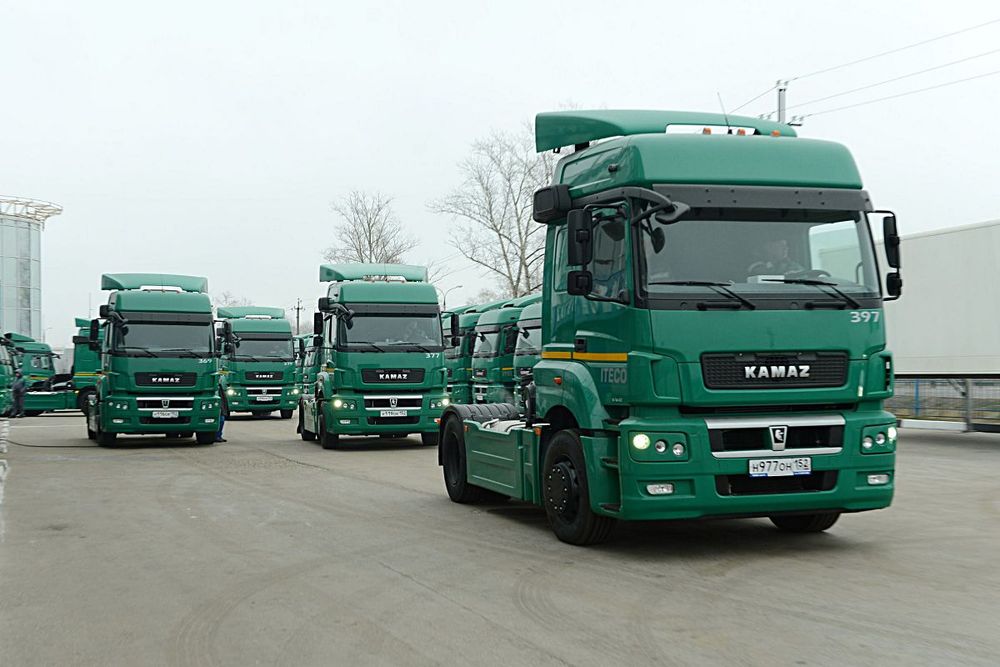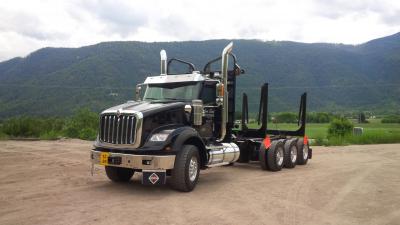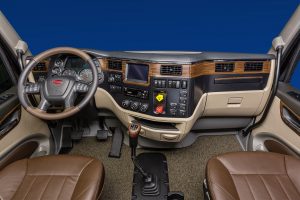
kscarbel2
Moderator-
Posts
18,855 -
Joined
-
Days Won
114
Content Type
Profiles
Forums
Gallery
Events
Blogs
BMT Wiki
Collections
Store
Everything posted by kscarbel2
-
PACCAR Australia Pty Ltd Press Release / September 26, 2012 Related reading: http://www.kenworth.com.au/trucks/k200/ http://www.kenworth.com.au/wp-content/uploads/2015/04/K200_web-PDF.pdf .
-
Owner/Driver / June 15, 2016 At the recent Alexandra Truck, Rod and Ute Show Larsen’s Truck Sales’ boss David Larsen rolled up with a rare ‘Smokey and the Bandit’ Kenworth W925 model. Peter and Di Schlenk took the chance to find out how he came by it This year’s running of the Alexandra Truck, Rod and Ute Show, held on June 12, had a host of impressive machinery on display, but none were as striking as a Smokey and the Bandit-themed 1976 Kenworth W925 model with its accompanying Pontiac TransAm. Both vehicles were part of the Larsen’s Truck Sales stand at Alexandra, the 20th running of the event. "It is just something different and it’s eye catching, especially for a show like this," company founder David Larsen explains. Larsen’s Truck Sales, the major sponsor of the Alexandra Truck, Rod and Ute Show, had nine on display, including the W model. David has little knowledge of the old Kenworth’s history. He had purchased it from another truck wholesaler in rust free condition. He then set about doing it up as a replica of the Smokey and the Bandit truck which featured in the 1977 movie. After all, it was of the same vintage, plus the TransAm which appeared in the movie was a ’77 model. "I want to thank those who helped transform the W925," says David, acknowledging the good industry relationships he has built over the years. "The truck was purchased 12 months ago and we have spent in excess of $100,000 on it." The Kenworth has a 335hp Cummins up front, a 15 speed Road Ranger gearbox and six-rod suspension. It’s a well-specced truck and David is hoping that someone will give it a great home. "Andrew Steffenson from Transmatt Truck Detailing was the main organiser who put it all together, while Shane Sluka from Total Diesel Services (TDS) did the mechanical work. "Ray Moyle from Prime Refinishing painted it, so it has been a joint effort by everybody and a good advertisement for us," David explains. TDS went through the truck from front to back, rebuilding what needed to be done, including installing a new clutch. David has had his trucks painted by Prime Refinishing for 23 years, and he has known Andrew 20 years. "I have been friends with these people for a long time," David says. "It’s the same with selling trucks; making sure that you do the right thing. It is a big industry but a very small world." David expected the Smokey and the Bandit W model Kenworth to some attention, but was surprised when it quickly attracted 1300 ‘likes’ on the Larsen’s Truck Sales Facebook page. "It certainly appeals to a lot of different people," David says. "People my age, in our 50s, recognise it and my boys do too. It’s a very iconic truck." Photo gallery - http://www.ownerdriver.com.au/industry-news/1606/rare-smokey-and-the-bandit-kenworth-w925-hits-alexandra/
-
KamAZ Trucks Press Release / June 14, 2016 The truck leasing subsidiary of KamAZ Group is supplying 100 model 5490 tractors to ITECO, one of Russia’s largest freight companies. Painted emerald green, the KamAZ-5490 tractors will be delivered between August and November. All the trucks are equipped with auxiliary heaters and electronic tachographs units featuring CIPF (Cryptographic information protection facilities) modules. This is ITECO’s third truck order with KamAZ-Leasing since 2014, as part of a planned fleet upgrade effort. ITECO took new 50 tractors in 2014, and another 50 units in 2015. According to the program "Recycling + Leasing" - "recycling" using leasing schemes - the customer will receive a discount of 400 thousand rubles for each acquired a truck. The "Trade-in + Leasing" will allow the lessee to take advantage of a discount of 350 thousand rubles for each truck. An additional benefit is advance payment on the program "Grace Leasing", in which the customer saves 10% of the cost of truck Versus the global brands, the KamAZ-5490 remains the best value in Russia’s truck market today. It features a comfortable, spacious and modern cab, and a powerful, fuel-efficient Euro-5 428 horsepower Mercedes-Benz OM457LA powerplant. For more information about KamAZ’s truck leasing programs, click here www.kamazleasing.ru. .
-
Reuters, AP / June 15, 2016 A 20-year-old Indiana man who was found with guns and explosive chemicals in his car on the way to a California gay pride parade has been formally charged. James Wesley Howell, who was ordered held on $2million bail, faces three felony counts of unlawful possession of an assault weapon, high capacity magazines, and explosives. Howell told police he was headed to the pride festival in Santa Monica around 5am on Sunday, just hours after the Orlando massacre began. Authorities have said there is no apparent link. Howell appeared at the Airport Courthouse in Los Angeles Tuesday, where he pleaded not guilty. In addition to the three felonies, he also faces a misdemeanor for the possession of a firearm in a car. Officers responded to reports of a man knocking on a window and found Howell sitting in his white Acura on Sunday morning. Howell was found with a high-capacity assault rifle, two other loaded rifles, magazines, a Taser, buck knife, handcuffs and security badge in his car when he was arrested. There was also a five-gallon container of gasoline in the white Acura, and a 25-gallon container of a commercially sold explosive was two-thirds full. The explosive, composed of two chemicals, had already been combined, and the assault rifle was loaded with a 30-round magazine, which had another inverted 30-round magazine taped to it. Deputy District Attorney Sean Carney said gun enthusiasts don't mix Shoc-Shot until it's ready to be used, as federal regulations require, and the amount that Howell had 'far exceeds any amount that would reasonably be used.' Alone, each item found in Howell's car might not indicate anything sinister, Los Angeles County Superior Court Judge Keith Schwartz said. But together, they 'just don't pass the common sense test.' 'I cannot in good conscience think of any reasonable reason that somebody would be traveling across the country with all of these things,' he said. Howell recently drove from Indiana to Los Angeles because of pending charges against him in his home state. Friends in Indiana described Howell as a gun enthusiast with a short temper. In October, he twice was accused of pulling a gun and making threats, once against his then-boyfriend and once against a neighbor. Howell was convicted in April of misdemeanor intimidation for the incident with his neighbor. Under the terms of his probation, Howell was not allowed to have weapons or leave Indiana. Howell’s attorney said a black hood found in his car was 'just a clothing item,' and nothing indicated Howell planned to use it as a mask, as police contended was a possibility. James Wedick, a former longtime FBI agent, said the manipulation of the gun magazines would allow someone to reload 30 rounds in less than 2 seconds. 'It doubles your killing capacity by 100 percent,' he said. For a civilian to have a weapon rigged as such, 'it suggests his purposes are deadly.' The FBI took the lead in the investigation and its probe continues. Federal agents searched Howell's Jeffersonville, Indiana, home Monday. On Tuesday, the sheriff's office in Clark County, Indiana, said Howell also is the subject of a sexual assault investigation. The alleged incident occurred May 31, about two weeks before Howell's arrest in California. Howell can face a sentence up to nine years and four months if found guilty on all charges. .
-
Associated Press / June 15, 2016 The top Democrat on the House Intelligence Committee says he wants to explore the potential for a system that would trigger an alert when someone who was previously on a terrorism watch list wants to buy a gun. Rep. Adam Schiff of California says an alert would allow law enforcement officials to consider anew whether an investigation ought to be reopened to determine whether the person who had expressed "radical thoughts is at the point of taking those into action." ------------------------------------------------------------------------------------------------------------------------ What's to "explore"? What's to debate? Make the change, effective immediately. An alert should have been standard protocol for decades, if not since 911.
-
I've always liked air starters. They've long been popular in Australia. AuStart offers an air starter for nearly every engine, including old Mack and Buda. http://austart.com/product-catalogue IR: http://www.ingersollrandproducts.com/am-en/products/air-starters/turbine-starters/150t-f-series http://www.ingersollrandproducts.com/am-en/products/air-starters/vane-starters/150bm-series
-
FYI Mack AC-460P Econodyne with 51qt. oil pan.pdf Mack AC-460P Econodyne.pdf
-
85 MS200 turbo question
kscarbel2 replied to Ajoyce76's topic in Antique and Classic Mack Trucks General Discussion
I'm not following you. -
Ford Trucks Press Release / June 14, 2016 Introducing the new 2016 Ford 1846T 13-liter 460-horsepower Euro-6 emissions (near EPA2010) 4x2 tractor. . Ford Trucks and You – "Sharing the Load" At Ford Trucks, we’re serious about trucking. It's why we designed the new 2016 Cargo heavy truck range from the ground up to meet your needs and expectations. See your authorized Ford heavy truck dealer for details, or visit the global Ford heavy truck website at https://www.fordtrucks.com.tr/ .
-
Heavy Duty Trucking / June 14, 2016 Lime Creek Logging Ltd. of British Columbia is the first business in Canada to get the new International HX620 Series truck, Navistar announced Tuesday. Lime Creek Logging is a family-owned business run by Shawn and Hank McIver, based in Grand Forks, B.C. They offer a full service stump-to-dump operation, managing 14 trucks and 40 pieces of equipment. The HX620 is configured as a tri-drive truck with a quad-logging trailer and is part of a four-truck deal with International dealer Cookson Motors, a division of IRL Truck Centres Ltd. “When we began developing and designing the HX Series, the customer and driver were at the center of our focus,” said Roman Lewinsky, president, Navistar Canada. “It was our goal to create a vehicle that delivers unparalleled driver satisfaction, a quality truck that is reliable with unprecedented uptime and provides the lowest cost of ownership. Those goals are being realized as we hand over the keys.” The International HX620 is a 120" BBC set-back axle truck or tractor suitable for a variety of applications including heavy haul tractor, logging, construction dump and platform stake/crane. Navistar says the new truck has been rolling off the assembly line since April at the company’s plant in Escobedo, Mexico. .
-
Nikola Motor Gets 7,000 Reservations for Unseen Electric Class 8 Truck Transport Topics / June 13, 2016 Nikola Motor Co. said it has received more than 7,000 reservations for its yet-to-be-unveiled electric Class 8 truck, the Nikola One. The company says the reservations represent $2.3 billion and were generated in the first month. Reservations for the electric truck are $1,500 and 100% refundable, according to its website. “Our technology is 10-15 years ahead of any other OEM in fuel efficiencies, mpg and emissions. We are the only OEM to have a near-zero emissions truck and still outperform diesel trucks running at 80,000 pounds. To have more than 7,000 reservations totaling more than $2.3 billion, with five months remaining until our unveiling ceremony, is unprecedented,” said Nikola Motor Co. CEO Trevor Milton. The Nikola One is capable of pulling 80,000 pounds with a range of more than 1,200 miles between stops. The truck has a 335-hp electric motor and dual gear reduction at every wheel, and offers a fully independent suspension — an industry first. “The Nikola One’s electric motors are powered by a liquid-cooled 320 kilowatt-hour, lithium-ion battery pack [more than 30,000 lithium cells], which is charged by a proprietary onboard Nikola Motor Co. turbine. The turbine automatically charges the batteries when needed and eliminates the need to ever plug in,” the company previously said. The turbine powers the battery bank and runs on natural gas but can be configured to run on diesel or gasoline, according to the company. The truck is capable of climbing a 6% grade at maximum weight at 65 mph, but a typical Class 8 diesel truck under similar conditions “would have a hard time reaching 35 mph.” The company will unveil the truck Dec. 2 during an event in Salt Lake City for media and reservation holders and for certain fleets and leasing companies. “We believe we will pass the current market leaders like Daimler, Paccar, Volvo and Navistar in sales orders within the next 12-24 months. Just imagine the orders that will come in, once we begin taking dealer applications. We have shown other OEMs and their shareholders why they should be nervous about Nikola Motor Co. Some of the top Class 8 dealerships in America have reached out and are willing to either add our brand or move away from their existing brands,” Milton said.
-
Yes, MH and RWI (US market 2nd generation Super-Liner) utilize the same chassis and air reservoirs.
-
"Shooting" death or other, murder is murder..........and I've a zero tolerance for one human being snuffing out the life of another. According to the FBI UCS Annual Crime Reports, the number of murders in the United States has actually dropped every year but one since Obama took office. (I didn’t vote for Obama. I'm just contributing some facts) As you can see, the murder rate rose progressively from 1960 to the 1991-1993 period, after which the annual numbers, despite a still growing population, began to fall. The threat of terrorism, and ongoing crime related to Latin-American drug cartels operating on American soil are serious issues. But all that said, the sad reality is that most of the 14,249 murdered Americans in 2014 were killed by...........Americans, Detroit and Baltimore are virtual war zones. With Ferguson, a bully/criminal was made a martyr rather than identified for what he was. Murders in the United States of America 1960 9,110 1961 8,740 1962 8,530 1963 8,640 1964 9,360 1965 9,960 1966 11,040 1967 12,240 1968 13,800 1969 14,760 1970 16,000 1971 17,780 1972 18,670 1973 19,640 1974 20,710 1975 20,510 1976 18,780 1977 19,120 1978 19,560 1979 21,460 1980 23,040 1981 22,520 1982 21,010 1983 19,310 1984 18,690 1985 18,980 1986 20,613 1987 20,096 1988 20,680 1989 21,500 1990 23,440 1991 24,700 1992 23,760 1993 24,530 1994 23,330 1995 21,610 1996 19,650 1997 18,208 1998 16,914 1999 15,522 2000 15,586 2001 16,037 2002 16,229 2003 16,528 2004 16,148 2005 16,740 2006 17,030 2007 16,929 2008 16,442 2009 15,399 2010 14,772 2011 14,661 2012 14,866 2013 14,319 2014 14,249
-
85 MS200 turbo question
kscarbel2 replied to Ajoyce76's topic in Antique and Classic Mack Trucks General Discussion
I hear you. I imagined a price around $800 to $1000. Borg-Warner is charging a premium due to low volume, and Volvo has its charge-the-most parts pricing policy. Years ago, this matter would be oh-so-simple. How about these folks? http://www.dieselusa.com/borg_warner.html http://midatlanticturbos.com/schwitzer.php http://webdiesels.com/schwitzer_turbo.htm Try contacting Borg-Warner directly for after-sales support..........http://www.turbos.borgwarner.com/ http://www.turbos.borgwarner.com/en/aftermarket/distributorSearch.aspx -
Jacobs Vehicle Systems Press Release / June 14, 2016 Jacobs Vehicle Systems®, the world’s leading manufacturer of diesel and natural gas engine retarding systems and valve actuation mechanisms, announces the launch of two engine brake models for Ford Otosan’s new generation, environmentally friendly and fuel efficient Ecotorq engine family. These launches mark the first joint development programs between Jacobs and Ford Otosan. The collaborative effort between Ford Otosan’s and Jacobs’ engineers resulted in two powerful and reliable engine retarders which augment Ford Otosan’s heavy duty Ecotorq engines and wide variety of truck offerings. The new engine brake models come standard on Ford Otosan’s new generation Ecotorq engines. These models implement bleeder brake and bridge brake technology for the 9 and 13 liter engines respectively. “Jacobs is proud to be part of the next generation Ecotorq product line by Ford Otosan,” said Sergio Sgarbi, President of Jacobs Vehicle Systems. “By combining Jacobs’ engine braking expertise with Ford Otosan’s strong product offering, we believe this launch will be a great success and the beginning of a strong technology partnership.” For more information on Ford Otosan’s vehicles and Ecotorq engines, visit Ford Otosan’s website. Visit Jacobs’ technology page to learn about Jacobs’ engine braking technologies. About Jacobs Vehicle Systems and Ford Otosan Jacobs Vehicle Systems is headquartered in Bloomfield, Conn., where it has a 25,000 square meter design, testing and manufacturing facility, with support sites in Europe, Japan, India as well as a manufacturing facility in Suzhou, China. Jake Brake® products are used by heavy and medium-duty diesel engine manufacturers globally. Registered to the ISO 14001 and TS16949 standards, Jacobs Vehicle Systems is the world’s leading producer of vehicle retarding and valve actuation technologies and can be found at www.jakebrake.com. Ford Otosan is a deep-rooted joint venture of Ford Motor Company and Koç Holding, playing an active role in worldwide automotive industry since 1959. Ford Otosan employs over 9,000 people including more than 2,500 R&D engineers in their 3 production plants, 1 warehouse and 1 R&D Base covering in total 1,600,000 square meter facilities in Turkey. Service and sales facilities are located throughout the world including Asia, Europe, and Africa. More information can be found at http://www.fordotosan.com.tr/en/ and www.fordtrucks.com.tr .
-
85 MS200 turbo question
kscarbel2 replied to Ajoyce76's topic in Antique and Classic Mack Trucks General Discussion
Thanks for giving Watts a try. This is a matter of Volvo overcharging, the folks at Watts have their hands tied. The Schwitzer option is 7536-X310327, and the Garrett option is 3316-X46561011 Schwitzer is now Borg-Warner, and Garrett is generally sold under the Honeywell name now. We started out with Garrett and later switched to Schwitzer, so you'll only find the latter as a replacement. What price did you get from these people? http://www.jhdiesel.com/BWTS-MACK.htm http://www.melett.com/turbo-model/3LM-363.html http://legacy.turbointernational.com/products/CartridgeDetails.asp?partNum=50721&turboModel=6552 You may have only paid $1800 for the truck, but that doesn't change the fact that items like turbochargers are expensive. You're going to have to accept that, balance it out knowing that you didn't pay much for the truck. -
http://www.bigmacktrucks.com/topic/30165-when-scania-trucks-roamed-north-america/#comment-167688 http://www.bigmacktrucks.com/topic/39056-driving-a-scania-is-‘better-than-sex’-truck-enthusiast-claims/#comment-280515
-
Those 2-Series and 3-Series Scania's will run forever. Because they were engineered and built like a Mack truck, they're still operating all over the world. Your red 112 tractor looks great.
-
Eurosatory is the world's largest international land and air-land defense and security exhibition. . .
-
85 MS200 turbo question
kscarbel2 replied to Ajoyce76's topic in Antique and Classic Mack Trucks General Discussion
Your part numbers are spot on.....good job. 7536-X310327 When you contacted the folks at Watts Mack (owner of the BMT website) about an exchange reman unit, what did they have to offer you? Their toll-free number is 1-888-304-6225 -
International puts the driver first in new product design initiative Truck News / June 13, 2016 International Truck has launched a company-wide initiative called DriverFirst that aims at giving its customers an edge in attracting and retaining qualified drivers through vehicles designed with a strong emphasis on the driver’s perspective. The new DriverFirst product design philosophy builds on International’s long-standing emphasis on customer uptime. “Today, for our customers, uptime means more than having trucks that are built to stay on the road,” said Denny Mooney, senior vice-president, Global Product Development. “Given the industry’s chronic driver shortage, it’s also about having enough drivers to operate those trucks. And for us, that means building trucks that will help our customers attract and retain drivers, by reflecting the driver’s point of view in the way they are designed and the technologies and features they offer. Simply put, we want to build trucks that drivers want to drive.” The DriverFirst initiative was inspired by customers’ and drivers’ input for International’s upcoming renewed product line, gathered from driver clinics, fleet feedback and studies of driver trends. Many customers told the company that due to the driver shortage, they are hard pressed to keep all of their trucks operating. These stories are consistent with quantitative reports from American Trucking Associations and other industry sources that the industry is currently 35,000-40,000 drivers short of meeting its needs. “The key takeaway from our research is that drivers want trucks that are designed to do the job,” Mooney added. “Drivers aren’t looking for something automotive or futuristic for its own sake. They just want something comfortable and functional, with a design that helps them do their job better and more easily.” Mooney said four specific areas where International is pursuing ongoing innovations and driver-centric features, based on its research into driver needs. They are: Comfort: Driver comfort is greatly enhanced by factors like ergonomics, interior lighting and color, as well as low noise, vibration and harshness (NVH). Safety: Driver safety can be enhanced by multiple factors, ranging from visibility and state-of-the-art headlights to advanced systems that use radar, digital cameras and other technologies to avoid and mitigate accidents. Productivity: Drivers benefit from technologies like automated manual transmissions, as well as improved vehicle serviceability and ease of maintenance. Efficiency: From improving fuel economy to designing more intuitive displays, drivers are interested in features that will help them get the job done more efficiently. “The DriverFirst philosophy has already helped us deliver multiple innovations, and it plays an even more prominent role in the new products that we will be bringing to the market starting this fall,” Mooney said. “We are committed to helping our customers improve the total driver experience, so they can encourage their drivers to stick around for the long haul.” Learn more about DriverFirst at www.InternationalTrucks.com/DriverFirst.
-
International's DriverFirst initiative to guide products Today’s Trucking / June 13, 2016 LISLE, IL – International has launched a new DriverFirst initiative that focuses on designing vehicles from the driver’s perspective – something the company says will offer customers an edge in attracting and retaining qualified personnel. "The DriverFirst philosophy has already helped us deliver multiple innovations, and it plays an even more prominent role in the new products that we will be bringing to the market starting this fall,” says Denny Mooney, senior vice president – global product development. "We are committed to helping our customers improve the total driver experience." Perhaps offering insight into what those products will be, DriverFirst focuses on four areas, International says: Comfort: Driver comfort is greatly enhanced by factors like ergonomics, interior lighting and color, as well as low noise, vibration and harshness (NVH). Safety: Driver safety can be enhanced by multiple factors, ranging from visibility and state-of-the-art headlights to advanced systems that use radar, digital cameras and other technologies to avoid and mitigate accidents. Productivity: Drivers benefit from technologies like automated manual transmissions, as well as improved vehicle serviceability and ease of maintenance. Efficiency: From improving fuel economy to designing more intuitive displays, drivers are interested in features that will help them get the job done more efficiently. The approach was born in driver clinics, fleet feedback, and studied driver trends, the company says. "The key takeaway from our research is that drivers want trucks that are designed to do the job," Mooney said. "Drivers aren't looking for something automotive or futuristic for its own sake. They just want something comfortable and functional, with a design that helps them do their job better and more easily." Learn more about DriverFirst at www.InternationalTrucks.com/DriverFirst.
-
International’s design philosophy is ‘drivers first’ Truck West / June 13, 2016 International Truck has announced DriverFirst, a company-wide initiative aimed at giving its customers an edge in attracting and retaining qualified drivers by engineering trucks with a focus on the driver’s perspective. During a conference call June 13, Denny Mooney, senior vice-president of International, said one of the biggest problems facing the industry is attracting and retaining drivers, and that in his recent talks with trucking companies, the concern over an impeding driver shortage continues to come up. “Given the industry’s chronic driver shortage, it’s also about having enough drivers to operate those trucks,” said Mooney. “And for us, that means building trucks that will help our customers attract and retain drivers, by reflecting the driver’s point of view in the way they are designed and the technologies and features they offer. Simply put, we want to build trucks that drivers want to drive.” Mooney said International would be refreshing its truck design in the next couple of years, and the company is getting input directly from drivers to determine how best to engineer those trucks. “Engineering opinions are not always the best opinion when it comes to drivers,” he said. Mooney added that International expects more women and younger drivers to enter the industry in the coming years, which is taken into consideration during the design process. He said International has brought drivers in to sit in clay models of prospective new trucks in an effort to get input on where controls should be located and what does and doesn’t work for them. The clay models have even been transported directly to customers so that several drivers can get the opportunity to provide input on the model. “The key takeaway from our research is that drivers want trucks that are designed to do the job,” Mooney said. “Drivers aren’t looking for something automotive or futuristic for its own sake. They just want something comfortable and functional, with a design that helps them do their job better and more easily.” Mooney said when designing new trucks, International focuses on comfort, safety, productivity and efficiency. The DriverFirst program reflects the company’s long-standing customer focus that it says has yielded a number of innovations, including the Bendix Wingman Fusion safety system and Over-the-Air Programming. “The DriverFirst philosophy has already helped us deliver multiple innovations, and it plays an even more prominent role in the new products that we will be bringing to the market starting this fall,” Mooney said. “We are committed to helping our customers improve the total driver experience, so they can encourage their drivers to stick around for the long haul.”
-
Peterbilt to launch Model 567 Heritage edition in September
kscarbel2 replied to kscarbel2's topic in Trucking News
-
Peterbilt to launch Model 567 Heritage edition in September
kscarbel2 replied to kscarbel2's topic in Trucking News
Peterbilt to offer special edition 567 Heritage Commercial Carrier Journal (CCJ) / June 13, 2016 Peterbilt is going back to its roots with its newest vocational truck offering, the special edition Model 567 Heritage, which combines modern technology with stylings like that of older Peterbilt models, the company says. The truck is configured with a 121-inch BBC set-forward front axle to optimize payloads and weight distribution, the company says, and it’s available as a day-cab or with a 72- or 80-inch sleeper. The truck also features a laundry list of exterior features including bright bumper, grille bars, exhaust stacks, mirrors and sun visor; chromed air intake bezel and metal hood latches; polished rocker panels, quarter-fender closeout panels, fender brace and brackets, battery boxes and fuel tanks; along with special Heritage badging. The interior of the truck features Heritage Brown interior with a black dash top and wood-finish trim; brown leather seats with accent stitching; and door pads with brown wood trim. Trucks equipped with a sleeper include wood trim accents on the sleeper cabinets and storage spaces. The Model 567 Heritage is available for order through Peterbilt dealerships with production scheduled for September. .
BigMackTrucks.com
BigMackTrucks.com is a support forum for antique, classic and modern Mack Trucks! The forum is owned and maintained by Watt's Truck Center, Inc. an independent, full service Mack dealer. The forums are not affiliated with Mack Trucks, Inc.
Our Vendors and Advertisers
Thank you for your support!












